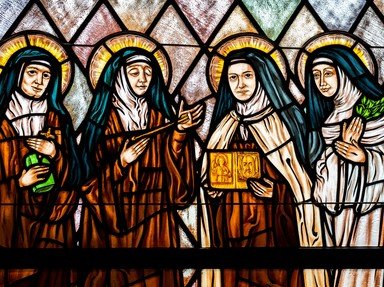Quiz Answer Key and Fun Facts
1. Therese's parents had both originally intended to join religious orders.
2. As a small child, Therese was a model of patience, meekness, and obedience.
3. In 1877, when Therese was just four years old, a tragedy struck the Martin family which would have a profound effect on Therese's character and personality; what was it?
4. In 1882, Therese's second-oldest sister, Pauline, joined a religious order. This was a great blow to Therese, as Pauline had been a second mother to her. Which order, which Therese herself would eventually join, did Pauline enter?
5. Therese suffered a serious illness in 1883, during which she had a vision in which a religious statue in her sickroom smiled at her. What statue was it?
6. In 1886, after a period of great spiritual trial and self-doubt, Therese underwent a spiritual epiphany which galvanized her determination to achieve a truly heroic state of holiness. On which major feast day did this occur?
7. Although she was determined to accomplish great deeds in the name of God, Therese was limited by her state of health and the restraints of her family (she was as yet only 14 years old). She nonetheless decided to achieve her goals through fervent prayer and contemplation. In 1887, she determined to bring about a change of heart and save the soul of a man she had never met, whose name was Henri Pranzini. Who was he?
8. In April of 1888, after numerous petitions and an appeal to the Pope himself, Therese was admitted into the convent at Lisieux. How old was Therese when she was admitted?
9. After taking her final vows, Therese began writing her autobiography, L'Histiore d'une Ame" ("Story of a Soul") at the direction of her sister Pauline, who by then was prioress of the convent at Lisieux. In this work, she famously identifies herself as a "little flower". Although she is often depicted holding an armload of roses, the "little flower" with which Therese identified herself with was this much smaller bloom.
10. Although she generally fulfilled her duties as a nun with diligence and enthusiasm, Therese's spirituality was very personal and far from conventional. Which of the following surprising statements about Therese is NOT true?
11. In 1896, the tuberculosis from which Therese had suffered for the past two years suddenly took a turn for the worse, and she began hemorrhaging. Ironically (and, perhaps, fittingly) this occurred in the evening or early morning between which two holy days?
12. Upon entering the convent, Therese had taken the name "Therese of the Child Jesus". Later, she added this appendage to her name, which was a reference to the passion of Christ.
13. Therese is venerated as the patron saint of florists and gardeners, and she is one of the three patron saints of France (the other two being St. Denis and St. Joan of Arc). The church also named her patroness of Catholic missionaries. For what reason were the missions placed under her patronage?
14. Therese promised after her death to send down a miraculous shower of roses from Heaven. Shortly after her death, a mysterious shower of roses from the sky did, in fact, occur.
15. Therese's process of canonization was one of the shortest in Church history. How long after she died did the Church declare her a saint?
Source: Author
jouen58
This quiz was reviewed by FunTrivia editor
bloomsby before going online.
Any errors found in FunTrivia content are routinely corrected through our feedback system.

